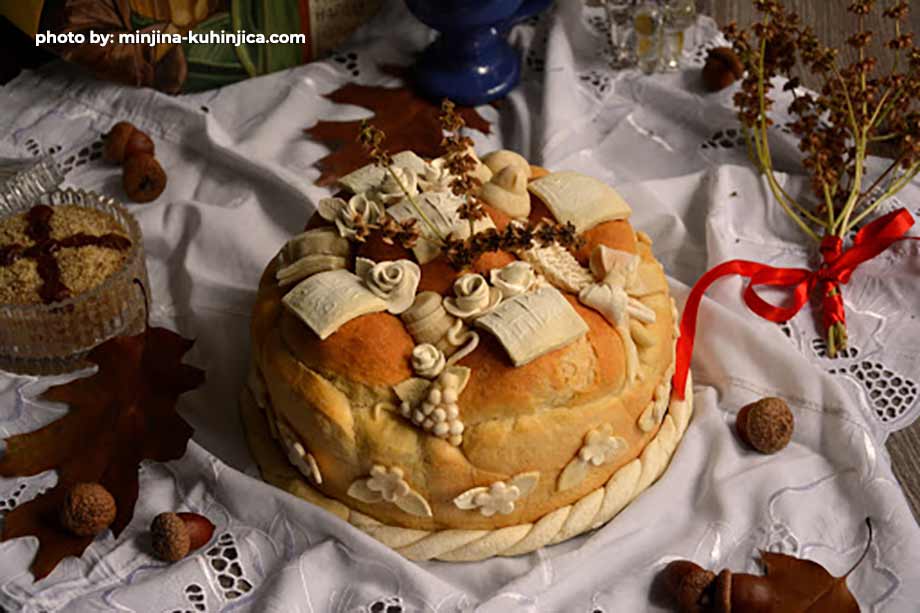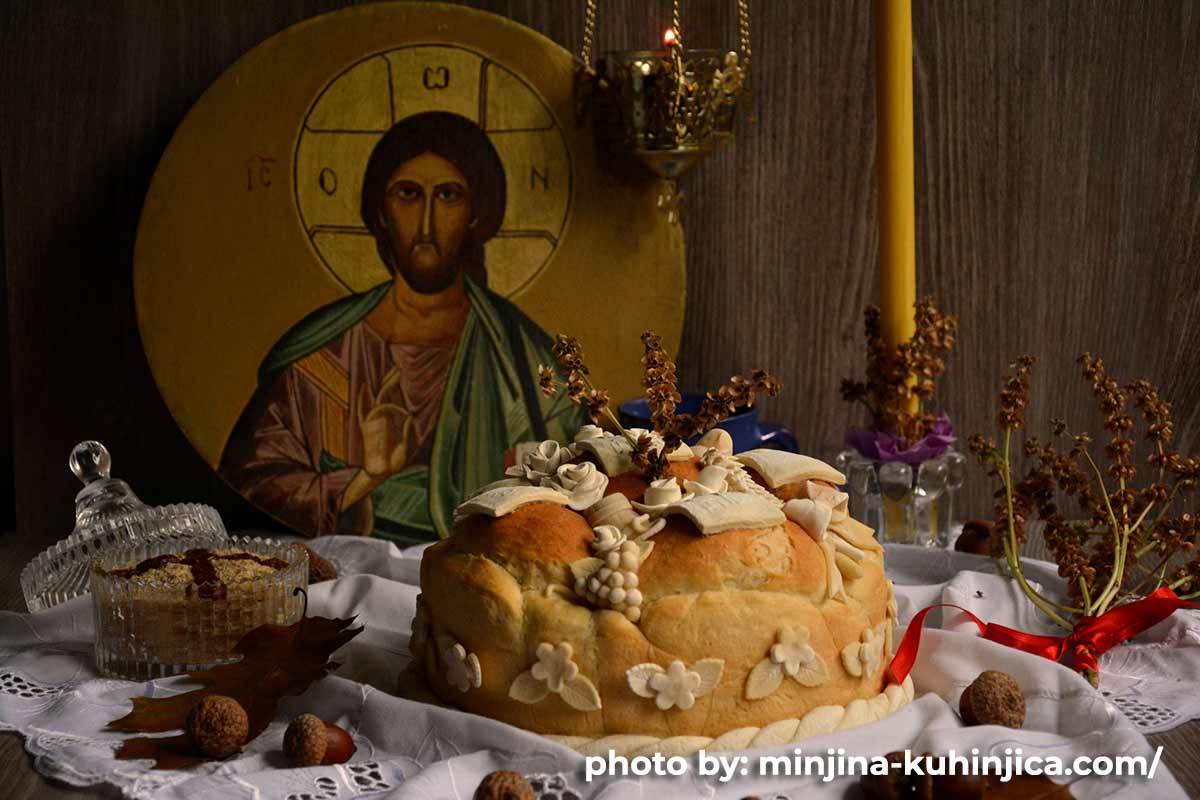Slava
Slava is the third most important holiday besides Christmas and Easter for Orthodox believers in Serbia and Republika Srpska. This beautiful family tradition is also called baptismal slava or baptismal name. Interestingly, Slava as a tradition is only celebrated by Orthodox Christian Serbians, so it is often presented as a sign of the identity of Serbs, which makes us unique in the Christian world. Well, most families in Montenegro and some families in parts of Northern Macedonia also celebrate Slava.
Slava – the beginnings
Before accepting Christianity, the Serbs believed in many gods and celebrated numerous pagan customs. The supreme God whom everyone worshipped was Perun. However, each home also believed in its family deity. Serbs who are sentimental by nature, very attached to their beliefs, had difficulties in renouncing pagan customs and accepting new, Christian ones. That did not go unnoticed. Namely, Rastko Nemanjić (Saint Sava) came to a very pragmatic solution, and polytheistic idols were replaced by great saints, who soon became protectors of homes throughout Serbia, churches, monasteries, families, and even villages and towns. In this way, the Slava as we know it today is created...

Slava - Significance for the Serbian people
How did Slava become such a well-founded tradition of the Serbian people? The reasons should be sought out in the significance that Slava had for the people throughout history. Rulers changed, life habits and numerous customs changed, only Slava remained the sanctuary of the Serbian people throughout history. Whether people lived in prosperity or the country was ruled by poverty and destitution, the Slava was celebrated. The Slava feast cake was broken among Serbian soldiers in the war, and the Troparion sang. Even in the darkest days of its history, during the five centuries of the Ottoman Empire Slava was celebrated. Slava lasted among the Serbs even during the extremely aggressive communist propaganda after the world wars. Simply, Slava kept faith, hope, and brought happiness and joy to family homes.
When does a family home begin with a celebration of Slava?
Slava is a tradition that is passed from generation to generation. Sons inherit Slava from their fathers and it has been so since time immemorial, and the tradition of transmission is so strong that it could be concluded that the families that celebrate the glory on the same Friday share the same family name. Over time, due to migration and displacement, many such families have moved away from each other.
When is it time for the father to pass Slava to his son?
As long as the sons and the father live under the same roof, Slava will be celebrated together. The first time a son starts his family, he should inherit Slava from his father and start celebrating it in his home. In recent times, one can often hear the misconception that Slava should not be taken as long as the father is alive and has the opportunity to celebrate Slava.
In the first year after starting a family, the son should come to the father's house to share the cake, who after sharing the cake with his dean's hand hands a quarter of the cake to his son, wishing him to continue celebrating happiness, health, and prosperity in the years to come. The following year, the son completely took over the Slava celebration from the father and celebrated it for the first time in his home.

photo: shutterstock
Slava - how to prepare for it?
Tradition says that the house should be tidy, and the family should be well dressed to welcome guests with dignity and solemnity. Before the celebration, the house is thoroughly cleaned and tidied. Also, it is time to give the family at least some piece of new clothes to welcome the guests in the new wardrobe.
In addition to preparing the house, the housewife prepares lunch, and Slava would not be complete without holy water. Namely, it is customary for the clergy to consecrate the water and the home where Slava is celebrated. To consecrate the water, a vessel with water, a small candle, an incense burner, incense, and a bouquet of basil should be prepared. It is desirable that all the occupants of the room where the icon of glory is located on the east wall of the room be present during the consecration. This custom differs in villages from urban areas. While the priest is in the villages "comes across" and consecrates the homes without prior "scheduling" in the cities, it is necessary to "make an appointment".
How do you invite someone to Slava?
The answer to this question will vary from end to end. While in some areas it is said not to invite to Slava in others there are many different traditions of calling. In some areas, by sending a bun or a small amount of homemade bread the host signifies an invitation to Slava. In other places, again, the host can personally go to the guest and invite him to the celebration in a cordial conversation.
Slava and The Slava bread
Of course, no Slava celebration can be complete without a celebration cake/bread. On the eve of the celebration, usually the day before, the housewife will knead a bread made of pure wheat flour. A little Epiphany or water that was previously consecrated by the priest should be added to the dough. The feast cake should be decorated, and on the upper side of the bread should be stamped with the letters ИС ХИ НИ КА, which means "Jesus Christ wins". The feast cake symbolizes the bread of Jesus' life and the wine that sheds the blood that flowed from his wounds.

photo by: minjina-kuhinjica.com/
The wheat dish for Slava
In addition to the celebration cake, the housewife prepares the celebration wheat, also called panaija or koljivo, before the celebration. Slava wheat should be prepared from cleaned and peeled wheat grain. Depending on the number of guests, the grain is cooked in clean water and then ground and dried. After drying, the sugar should be added, ground walnuts, and a little vanilla sugar to taste as well. After that, it should be nicely shaped in a shallow bowl and sprinkled with ground walnuts on the surface. A small candle is placed in the celebration wheat, which should be lit during the ritual of „bread (cake) breaking“ when it is then extinguished, and the grain is sprinkled with red wine.
Celebration candle for Slava
The candle that is used for the celebration should be made of pure wax, about 50 cm long. It is placed in a candlestick and specially decorated. It is lit on the day of celebration just before the bread cake is cut. The candle should burn until almost the very end when, and it is extinguished with the following custom - The host takes a glass of wine, crosses, and takes a spoonful of wine from it, which he pours on the wick and extinguishes it. After that, the candle is placed in front of an icon or some similar festive place in the home.
What should a festive table look like?
In addition to the festive wheat, cakes, and wine, according to the folk custom, a festive lunch is prepared for the celebration, which is performed on the day of the celebration. There are customs to invite to dinner before Slava and to celebrate Slava for several days. Although the celebration of Slava is primarily a spiritual event, the need for the celebration table to be plentiful and to often overdo it has somehow become established among the people. Thus, Slava celebrations can often be a problem for families who cannot financially support such a celebration.
A common mistake when preparing a feast is not paying attention to whether the feast is fasting. Namely, many celebrations fall on the day of fasting and as such, they should have a fasting meal. One of the most popular holidays - St. Nicholas (St. Nicholas) falls during Christmas fasting. Preparing greasy food is a great sin and it is better not to celebrate the glory than to prepare a table that is not fasting during fasting.
Label and copyright: Cobra Film Digital distribution: Youtube powered by: http://vipper.tv/
How are guests greeted?
In a festive atmosphere, festively dressed and in a good mood, the host welcomes his guests on the day of the celebration. A good host will not sit until he welcomes guests who congratulate him with the words: "Happy Slava to the host (Srećna slava domaćine), to you, your home and your family for many years in joy." To which the host responds with the words: "Thank you, welcome to us and may God and the patron saint help us to come to us for many years and to celebrate in health and joy." After that, the guests are arranged according to their age at the festive table.
Srećna slava domaćine!










